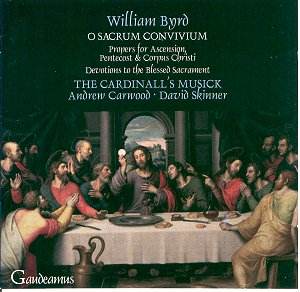I
have a problem with this CD. Now let me say at once that it
is a fine production from Gaudeamus. The ‘realisations’ by David
Skinner are beautifully conceived and the singing by The Cardinalls
Musick is timeless. The presentation of this CD is enhanced
by a contemporary (of Byrd’s) painting of the Last Supper
by Juan de Juanes. The sound quality is ideal: it is not hard
to imagine being in a cathedral or monastery instead of the
fireside, whilst listening to this CD on a good quality sound
system. Furthermore this present disc is Volume 9 from an ongoing
review of William Byrd’s music. I do not like to use the phrase
‘greatest composer’ of anyone from any era, but there is no
doubt that Byrd, along with Thomas Tallis are two of the brightest
stars in the history of British music. And the perfection of
the music on this CD highlights this brilliance and genius.
Now to the big
problem! How do you actually listen to this CD? Do we need to
define some strategy for approaching the 26 tracks on this disc?
Let us state the obvious: it is not the sort of music that can
be listened to at a dinner party or a quiet tęte-a-tęte with
the beloved. This is not background muzak that can be chatted
over with a glass of wine in one hand and a Hamlet in the other.
A further problem exists with the context of the music. This
is not a Mass setting or a song-cycle or a set of dances for
entertainment; this is the ‘Proper’ of the Mass.
Let me explain. In the days before
‘wiser’ heads destroyed much that was good in Roman Catholic
Church liturgy and replaced a fine and venerable Latin rite
with a somewhat pedestrian English one, there were many opportunities
for ‘poetic’ texts of the day. It is important to recall that
the Mass or Vespers can be separated into two key elements –
the Ordinary and the Propers. The Ordinary, as its name implies
are those texts which typically do not vary from day to day,
week to week or season to season. These include such well known
settings as the Agnus Dei, the Credo, the Magnificat (Vespers)
and the Gloria. The Propers on the other hand relate to the
season or to the Saint’s Day or Sunday. They change from Mass
to Mass and are found in the Missal or Breviary. These include
antiphons (a short text sung before and after a psalm or canticle)
for the Magnificat and psalms, music sung at the offertory and
communion and perhaps an Office hymn. The perusal of these Propers
contributes much to our appreciation of the swing of the church’s
year.
Now
back to the problem. The ‘Propers’ are all good and well; they
are beautiful artistic creations that lift our minds to God
(if we believe in him) and help us understand in a practical
and mystical way the timeless elements of the Christian faith.
Great! But in this CD, by definition, they are divorced from
the rest of the Mass or Vespers. They are sung one after the
other without the intervening texts, readings and liturgy. Packed
onto this CD we have the ‘Propers’ for the Feasts of the
Ascension, Pentecost and Corpus Christi - three of the greatest celebrations in the church’s calendar. But
there is no breathing space. They would never have been listened
to in this close connection; there would have been Gospel readings,
Mass settings, censings and processions not to mention the homily
and perhaps organ or instrumental voluntaries.
So
what is our strategy for listening to this CD?
One
suggestion only. First of all take a Feast at a time. Do not
through play this CD. It will just wash over you. Secondly,
find a setting of the Mass (how about Byrd’s Mass for Four Voices?)
or a Magnificat that you particularly enjoy and have
the CD close at hand. If you have a missal or a bible, look
up the relevant passages. Open the CD booklet to the texts and
translations page. Be prepared to swap CDs around in the machine.
Put on a recording an organ voluntary, grab the remote control
and get ready to realise your own Mass. There is a batting order and I add this below. I have indicated the
relevant tracks on the CD.
|
Feast of Ascension
|
Feast of Pentecost
|
Feast of Corpus Christi
|
|
Introit [1]
|
Introit [9]
|
Introit [17]
|
|
Kyrie
|
Kyrie
|
Kyrie
|
|
Gloria
|
Gloria
|
Gloria
|
|
Epistle
|
Epistle
|
Epistle
|
|
Alleluia [2] [3]
|
Alleluia [10] [11]
|
Alleluia [18]
|
|
Gospel
|
Sequence [12]
|
Gospel
|
|
Creed
|
Gospel
|
Creed
|
|
Offertory [4]
|
Creed
|
Offertory [19]
|
|
Agnus Dei
|
Offertory [13]
|
Agnus Dei
|
|
Communion [5]
|
Agnus Dei
|
Communion [20]
|
|
Hymn [6]
|
Communion [14]
|
|
I
know that this table accounts only for the Propers of the Mass.
Included on this recording are a few Antiphons for the Magnificat
and the Benedictus. Traditionally the Magnificat
was sung at Vespers and the Benedictus was sung at Lauds
(the second of the seven traditional daily offices of the church).
But for our purposes there would be not problem in hearing them
after the end of the ‘Mass.’
Or perhaps to listen to the Magnificat by Tallis with
the antiphons provided on this disc?
I
believe that the five settings from the Devotions to the
Blessed Sacrament can be listened to in order as long as
they are followed in the text provided with the CD and a realisation
that this is one of the most moving, if somewhat extravagant,
rituals in the Catholic tradition.
This
is a great CD and is part of a fine series. It is essential
listening for all interested in liturgical music and the works
of one of the ‘greatest’ British composers.
Another
volume in a fine series exploring the works of one of Britain’s greatest composers. These liturgical works are superbly realised
and beautifully sung by The Cardinalls Musick.
John France

![]() The Cardinalls Musick/Andrew Carwood
The Cardinalls Musick/Andrew Carwood![]() SANCTUARY CLASSICS – GAUDEAMUS GAU 332 [74:27]
SANCTUARY CLASSICS – GAUDEAMUS GAU 332 [74:27]





